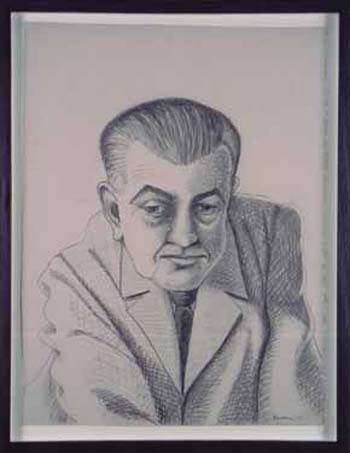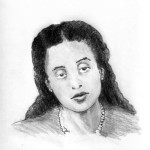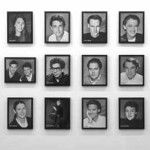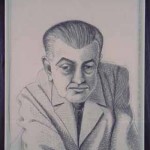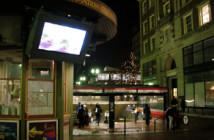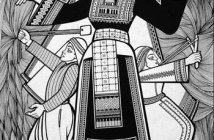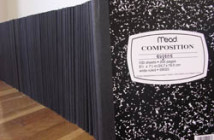Currently up at the ICA is Likeness: Portraits of Artists by Other Artists, a show organized by Matthew Higgs as part of the Independent Curators International stable of cutting edge and affordable shows. The exhibit gathers a history of contemporary artists’ representations of other artists--of friends, peers, and idols. The texts surrounding the exhibit suggest that portraits of artists by artists exploit the already captivating doubleness of the portrait as both a document and a personal record of the relationship between the artist and his or her subject. In such works, the identities and status of both portrayers and portrayed are interrelated and conflatable. The many photographs, paintings, and drawings in the exhibit apparently represent a loose network of artists primarily active in New York, Los Angeles, London, and Berlin. There are works by David Armstrong, AA Bronson, Bruce La Bruce, Chuck Close, Tacita Dean, Sam Durant, Nan Goldin, Felix Gonzalez-Torres, Richard Hamilton, Mike Kelley, Sean Landers, Robert Mapplethorpe, Richard Misrach, Dave Muller, Paul Noble, Julian Opie, Elizabeth Peyton, Sigmar Polke, Richard Prince, Wolfgang Tillmans, James Welling, and others. I visited on Wednesday.
When I returned from this first visit to Likeness: Portraits of Artists by Other Artists, I sat down with my laptop and worked on what I imagined was a blistering review of a horrendous show. I wrote only one paragraph, but it included lines like, “was this readymade exhibit from Matthew Higgs a soft sell to its host museums? I imagine that it was. For the cost of begging, borrowing, and collating works by X many artists, the host museum gets the advertising bang of 2X + some,” and “in the end, the gross is plain gross.”
My criticisms, while completely ill-defined, ran something along the lines of annoyance with a show that contained so many artworks that felt like lifestyle porn. A portrait is one strange beast, but a portrait by an artist of an artist friend is another. To complicate the subjects of the portraits of artists in the show (the eventual turn of thought that makes looking at any portrait so delicious) seemed to require a desire for intimacy with art world celebrity. One that I did not have, and did not want to want.
That review was never realized, let alone published on BRS. This is because I also decided to e-mail Joe Zane, a Boston artist whose portraits of artists from the 70’s are included in the iteration of Likeness that is at the ICA. I pronounced the show horrendous, although this was meant to be a compliment that positioned his drawings as its sole point of brightness. Zane wrote back, somewhat mystified:
I must say, it feels a little strange to talk about it when you open your email by telling me the show is 'horrendous'. Maybe you could tell you me what you mean by that…I’m not sure what you mean 'readymade show'?”
I hope to hear from you soon.
Joe
What follows is an e-mail thread, a mocked-up transcript of our discussion of Zane’s work. His is an ongoing series of drawings of artists like Marcel Broodthaers, Ed Ruscha, and Robert Smithson, all from photographs taken in the 70’s. Five of these portraits were included in Likeness. We discuss them, the exhibit itself, and my insistence on reading his work as a clever and self-conscious intervention in a pre-existing show.
____
AEL: I am curious about the whole genesis of your ongoing series. What impacts your choice of artists in your series of artist portraits? How do you choose the photograph that you will use as your source image? Which artist did you draw first?
JZ: The last question is the easiest so I’ll start there. Mel Bochner was the first (although that drawing is not in the Likeness show) and that was followed almost immediately by Vito Acconci. Like most art, I started picking an artist for one reason and it kind of took on a life if its own. I started doing the portraits right out of grad school as a way to relax before I started making new work. I was drawing people that have had an impact on me as an artist. I was trying to situate myself in some sort of art (historical) context. Actually, most of my work is of this nature...
I was concentrating on a group artists from the late 60's and early 70's (right around the time I was born. This seemed somehow important to me). In my mind this was a period of great opening up in art. Everything that artists feel the freedom to do now comes from this period. We had early electronic art. Performance art. Feminist art. Conceptual art. Minimalism. Great art questions were being asked. What is an object? Where does art belong? What is the purpose of art? Really good stuff.
Naturally, it turned out I had opened a huge can of worms and as I started drawing more artists, the list of other artists I wanted to draw kept getting bigger and bigger. All of a sudden I had thirty-some-odd drawings and still a big list to go. I look for certain character in the artist's work as well as a relation not just to history, but to the other artists in my grouping. I started trying to develop interesting relationships between artists through their images, by grouping their pictures together.
As for what kind of photo I’m looking for, it is a mixture of things. The photo has to be from the late 60's, early 70's (which interestingly was when many of the artist I drew were the age that I am now). The person must either be looking at the camera or in 3/4 view. This is so that I can draw them in what I like to think of as a “yearbook look.” Many of these artists are thought of as being very radical or intellectual (pretty much art nerds) so I tried to draw them looking young and attractive. Cute. Personal.
AEL: When I went to see Likeness, I found myself playing who's who and testing myself to see how many artists I could recognize before I checked the wall text. I hope that wasn't just the shallowness of my purpose there since I knew I was going to try to write a review…I think that kind of name recognition was invited. Of the five portraits from your series that are in Likeness, I was excited to recognize not just Adrian Piper the artist, but also the actual specific image of Adrian Piper that you had selected for your portrait. Isn't that the image from her famous piece where her head appears on a monitor behind an overturned table? I recognize the tilt of the head. I have to admit that I don't remember the details of her piece itself (I don't remember if she is speaking or if the video actually has elements other than just a shot of her head), but the image of it that I see in magazines and textbooks is unforgettable. You talk about relationships between artists and their images…it is amazing to me to think about how influential the choice of a single still from a temporal work like Piper's is in my experience and understanding of their work.
Off the top of my head, it felt to me like the works in Likeness were all either photographs, or paintings and drawings FROM photographs (by people who didn't know the artists they were painting and drawing). Would you call your series a series of portraits? Portraits of what?
JZ: Right. Is it a portrait of the artist? A portrait of their 'image' (in the celebrity sense of the word)? A portrait as kind of lineage or connection to the person drawing it? Or by the same token a portrait of the person drawing it? That’s really the question behind the exhibition, not just my work.
As far as how they were made, everybody works differently. I'm pretty sure Elizabeth Peyton did those portraits from life and I know that she knew people she painted. Chuck Close always knows the person he paints. I'm pretty sure that David Robbins knew all the artists in his photo series (which is brilliant and not completely unlike what I did). Some of the portraits are quite personal. It goes without saying that AA Bronson's photo of Felix Partz is one those.
AEL: Oh God yes, that portrait of a wasted, dead friend is unbelievably personal and wrenching, though maybe I would try to say that it's not a portrait of Partz so much as it is a portrait of the waste of AIDS.
You caught the errors in my attempt to sort the work into the two types: the haves [access to the aristocratic sphere of famous artists]and the have nots [clever wannabes who make art of their desires]. Elizabeth Peyton I think does paint from life. Chuck Close doesn't, but he totally owns the images of his friends in a way that is intimate.
But it was still interesting to me that the show professed to take up artist-as-celebrities worthy of our attention, where Warhol left off. As a schlubby gallery goer, I actually felt annoyed at times. The private, privileged network of artists that the show acknowledges and promotes...is it really a given that the personal lives of artists and their artist friends is interesting and something that I care about? I guess I'm just rephrasing what gets said about Warhol. I don't know. What do you think? As an artist, I suppose you felt like the show at least invited your own work’s participation and in that sense was interestingly inclusive.
JZ: Well, to go to Bronson's photo for a just a quick second. To me, it is certainly a portrait of Partz. There's a tenderness to it that makes me feel this. It has to do with the all the color and pattern and that surrounds him (in his clothes and the bed sheets). It is a remembrance of a dear friend, not a dark morbid image of death and decay.
Anyway. No, I don't think it is a given that the personal lives are interesting at all. But isn't that always the case? Is Brad Pitt and Jennifer Aniston's breakup really headline news? If anything, for me, there is a certain amount of humor in the notion of artist as celebrity. And it’s also a little pathetic.
There's probably a lot more that can be said here. Not just the nature of celebrity, but also the difference between the artist's work and their image and their 'image'. You know what I mean?
But as far how I felt to be invited in the show, I felt great. Yes, I thought it was interesting to be in it, but it felt comforting in a way. From my perspective it feels like sharing with the other artist in the show. "Here's mine." and "oh, I did a Smithson too...." that kind of total art nerdiness thing.
AEL: Maybe you can say a bit more about the art nerdiness thing. I'm really enjoying this exchange of your benevolent take on what seems to be a shared anxiety of influence...the Andy homages, and that glamour shot of Mary Kelly. It's not clubby. It's sweet and nerdy and celebratable.
JZ: The area of the show that my work is in seems to be all about younger artists dealing with older artists. An interesting relationship got set up by positioning me across from the Sean Landers portraits. His are essentially the same as mine; looking back and imaging a generation of artists that you admire for one reason or another, a kind of wanting that is very exposing in some ways. But there is a generation gap between me and Sean and the effect of that is pretty remarkable. It gets weaved up and very complicated. Sean did portraits of people like Duchamp who was an influence on the generation of artists that I did portraits of who were the guys that were teaching in art school when Sean was in grad school, who was teaching in a grad program when I was in grad school....follow that?
That’s pretty nerdy and very interesting to me. Art is always shifting and the tug of influence gets shifted with it. It’s great to think of an artist you really like and then to think,"who are they looking at?" And is their work an extension of the older work? Or rebellion against it? Did they look back at these older artists with contempt, or reverence or humor?
That Mary Kelly photo is really funny. Mary Kelly is the last artist you would picture lounging by the pool. She's much too serious for that. Now the question of course is, do you have to know all the webs and history in order to 'get' the show? I don't think so. That's what's great about a portrait show. Everyone gets a portrait. It’s a picture of someone. Does it help to know who that someone is? And what their relationship to the artist is? Of course, that's been the case since Manet (and certainly before that too). But you don't need that to enjoy a good portrait. There are some really good portraits in that show.
AEL: The only way the Mary Kelly photo is really funny is if you know who she is and feel some kind of personal connection with her. The wall text helps people “get it” but not well enough to make it a funny piece. Do you think Helen Cantrell [the artist]thinks it’s funny? I think she is up to something else.
As you mention, the transmission of artistic ideas happens in grad programs and universities. Mike Kelley, whose portrait of a fellow collaborator from Destroy All Monsters is in Likeness, has some amazing things to say about what he considers basically a brutalization by education. He has written about re-examining and repainting his old paintings within a framework of Repressed Memory Syndrome, the cases where abuse cases have been decided solely on the convincing testimony of the victim recounting their newly remembered memories of abuse. Kelley wrote in an exhibition catalog, “This is what first drew me to reexamine my old paintings (This and the fact that much of my viewing audience seeks to make sense of my work by psychoanalyzing it, and often by postulating that I must have suffered some sort of childhood abuse. In general they don't postulate institutional abuse as a cause for the strangeness of my artistic output.) My presumption was that my recent aesthetic production must in some way be affected by my art training, even though I consciously rebelled against this training and saw no particular connection formally between my recent work and my student work. The "symptoms" of my recent work must be the by-product of elements of my training that I repressed. And, the repression proves, this training must have been traumatic -it must have been a form of abuse. I chose to confront my old works, to consciously relearn the rules under which I produced them, in order to perhaps understand my abuse and to more consciously deal with it in future art works. I did this by painting on top of the old paintings.”
I know this has become an unwieldy question, but would you ever admit not an anxiety of influence, but a tyranny of influence? Do you imagine Sean Landers might? His method of drawing his portraits is less loving and precious, more ugly. I thought it was a similar style of mark to R. Crumb.
JZ: I would never want to speak for Sean Landers. He does a good job of that himself. Mike Kelley certainly has a lot to say about schooling and probably rightfully so. Grad school can certainly feel like abuse. I recently read a book in which MFA programs are referred to as “two-year hazing rituals you go through before becoming an artist.” I don't think the kind of trauma and angst that Kelley is talking about applies to my work (at least not the portraits). Honestly, I’m not sure what you’re asking yet. Can you rephrase? I am not sure the kind of institutional influence that you bring up in the Kelley quote is relevant to my portraits. I certainly don't harbor feelings of tyranny towards any of the artists I drew.
AEL: I was simply asking about these networks of artists. There are networks of collaboration like many of those in the show. And there are networks of influence that go in one direction more than in the other, again like many of those in the show. I was trying to parse what connections you felt to the artists you draw. They are giants in the field, and you draw them like idols. More glossy than Landers. I imagined that this idolatry might be a demon that you were fighting or at least exploring. But, I suppose that's more what I'm bringing to it than what you are bringing to it.
JZ: Ok. Well, honestly I feel very fortunate to know these artists works. I feel like they have contributed somehow a great deal to who I am as an artist. It is certainly something I'm exploring though.
AEL: Last question, then. Which portrait in Likeness do you like best?
JZ: You mean the entire show? Probably David Robbins, Talent, is my favorite. It is nine portraits and not one, so that might be cheating. I think it’s just perfect. Everything about it is great. To me it totally sums up the 80's. Andy Warhol was on MTV, the celebrity artist was “a thing.” The idea of artist as entertainer was entered into the vocabulary. So Robbins takes these young swaggerish artists and gives us headshots of them (with those great 80's hairdo's). It's just wonderful.
Let me ask you, do you still find the show horrendous?
AEL: Nope! But it will never be my favorite type of show. The pieces are interesting, and I enjoyed our conversation really very much. But I still think that portraits of artists by artists is a kind of theme that doesn't allow for heart or mind swelling in more than one direction. There weren't many "portraits of humanity" or images that seem so real that my consciousness is branded. That sounds lame, and you were right from the start that that's some ridiculously narrow criteria, but I'm going to cling to it. There is quite a lot left to talk about, too. I steered us one way but the discussion could have gone in many others, and that's exciting.
My favorite is Tacita Dean's film of Mario Merz.
JZ: Yes. Sometimes it’s tough to look at shows now. There is so much put on 'relevant' shows (read: political or socially motivated). While that stuff is really great and very important to have in the artistic climate, sometimes it’s nice to kick back and enjoy a nice portrait show. But, I'm biased for many reasons. One them being that I love art about art. So for me, this show is a real kick.
I loved the Tacita Dean film too. It was very touching and beautiful. Mario Merz is actually on my list of artists to draw. I even have good photo of him…
- Joe Zane, Adrian Piper, 2003
- David Robbins, Talent, 1986.
- Sean Landers, Magritte, 2003.
Links:
JoeZane.com
Uncertainty-Principle.com
The Institute of Contemporary Art
Independant Curators International
"Likeness: Portraits of Artists by Other Artists" is on view through May 1, 2005 at The ICA.
All images are courtesy of the artist and The ICA.

